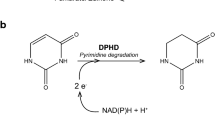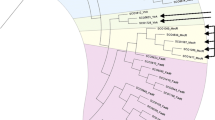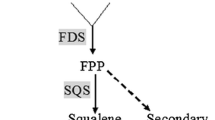Summary
The UGA3 gene of Saccharomyces cerevisiae is required for 4-aminobutyric acid (GABA)-dependent induction of the UGA1, UGA2 and UGA4 genes which encode the two GABA catabolic enzymes and a GABA-specific permease, respectively. Measurements of UGA1-specific transcripts show that induction of UGA1 correlates with accumulation of its RNA and requires a functional UGA3 gene. A 2 kb DNA fragment complementing the uga3 mutation was isolated and shown to contain the UGA3 gene. The primary structure of the UGA3 encoded protein was deduced from the DNA sequence, and contains an N-terminal, cysteine-rich motif similar in sequence to regions found in other fungal regulatory proteins and which are supposed to form zinc finger structures involved in DNA binding. Mutations were identified in the UGA3 genes isolated from uninducible and constitutive uga3 alleles. One case of intragenic complementation between two uninducible uga3 mutants is reported, indicating a possible oligomeric structure for UGA3. The role of UGA3 is discussed in relation to its genetic properties and its predicted structure.
Similar content being viewed by others
References
Balzi E, Chen W, Ulaszewski S, Capieaux E, Goffeau A (1987) The multidrug resistance gene PDR1 from Saccharomyces cerevisiae. J Biol Chem 262:16871–16879
Baum JA, Geever R, Giles N (1987) Expression of qa-1F activator protein: identification of upstream binding sites in the qa gene cluster and localization of the DNA-binding domain. Mol Cell Biol 7:1256–1266
Béchet J, Grenson M, Wiame J-M (1970) Mutation affecting the repressibility of arginine biosynthetic enzymes in Saccharomyces cerevisiae. Eur J Biochem 12:31–39
Bennetzen JH, Hall BD (1982) The primary structure of the Saccharomyces cerevisiae gene for alcohol dehydrogenase. J Biol Chem 257:3026–3031
Beri RK, Whittington H, Roberts CF, Hawkins AR (1987) Isolation and characterization of the positively acting regulatory gene QUTA from Aspergillus nidulans. Nucleic Acids Res 15:7991–8001
Chevallier MR, Bloch JC, Lacroute F (1980) Transcriptional and translational expression of a chimeric bacterial-yeast plasmid in yeast. Gene 11:11–19
Chou PY, Fasman GD (1978) Empirical predictions of protein conformation. Annu Rev Biochem 47:251–276
Dang CV, Lee WMF (1988) Identification of the human c-myc protein nuclear localization signal. Mol Cell Biol 8:4048–4054
Evans RM, Hollenberg SM (1988) Zinc fingers: gilt by association. Cell 52:1–3
Frankel A, Chen L, Cotter RJ, Pabo CO (1988) Dimerization of the tat protein from human immunodeficiency virus: a cysteinerich peptide mimics the normal metal-linked dimer interface. Proc Natl Acad Sci USA 85:6297–6300
Friden P, Schimmel P (1987) LEU3 of Saccharomyces cerevisiae encodes a factor for control of RNA levels of a group of leucine-specific genes. Mol Cell Biol 7:2708–2717
Green S, Kumar V, Theulaz I, Wahli W, Chambon P (1988) The N-terminal DNA-binding “zinc-finger” of the oestrogen and glucocorticoid receptors determines target gene specificity. EMBO J 7:3037–3044
Grenson M, Mousset M, Wiame J-M, Béchet J (1966) Multiplicity of the amino acid permeases in Saccharomyces cerevisiae. I. Evidence for a specific arginine-transporting system. Biochim Biophys Acta 127:325–338
Grenson M, Muyldermans F, Broman K, Vissers S (1987) 4-Aminobutyric acid (GABA) uptake in Baker's yeast Saccharomyces cerevisiae is mediated by the general amino acid permease, the proline permease and a GABA-specific permease integrated into the GABA-catabolic pathway. Life Sci Adv Ser C 6:35–39
Hartshorne TA, Blumberg H, Young ET (1986) Sequence homology of the yeast regulatory protein ADR1 with Xenopus transcription factor TFIIIA. Nature 320:283–287
Ito H, Fukuda Y, Murata K, Kimura A (1983) Transformation of intact yeast cells with alkali cations. J Bacteriol 153:163–168
Jacobs P, Jauniaux J-C, Grenson M (1980) A cis-dominant regulatory mutation linked to the argB-argC cluster in Saccharomyces cerevisiae. J Mol Biol 139:691–704
Johnston M (1987) A model fungal gene regulatory mechanism: the GAL genes of Saccharomyces cerevisiae. Microbiol Rev 51:458–476
Kalderon D, Roberts BL, Richardson WD, Smith AE (1984) A short amino acid sequence able to specify nuclear location. Cell 39:499–509
Kammerer B, Guyonvarch A, Hubert J-C (1984) Yeast regulatory gene PPR1. I. Nucleotide sequence, restriction map and codon usage. J Mol Biol 180:239–250
Keegan L, Gill G, Ptashne M (1986) Separation of DNA binding from the transcription-activating function of a eukaryotic regulatory protein. Science 231:699–704
Kim JK, Michels CA (1988) The MAL63 gene of Saccharomyces cerevisiae encodes a cysteine-rich finger protein. Curr Genet 14:319–323
Landschulz WH, Johnston PF, McKnight SL (1988) The leucine zipper: a hypothetical structure common to a new class of DNA binding proteins. Science 240:1759–1764
Laughon A, Gesteland RF (1984) Primary structure of the Saccharomyces cerevisiae GAL4 gene. Mol Cell Biol 4:260–267
Messenguy F, Dubois E, Deschamps F (1986) Nucleotide sequence of the ARGRII regulatory gene and amino acid sequence homologies between ARGRII, PPRI and GAL4 regulatory proteins. Eur J Biochem 157:77–81
Miller J, McLachlan AD, Klug A (1985) Repetitive zinc-binding domains in the protein transcription factor IIIA from Xenopus oocytes. EMBO J 4:1609–1614
Nishizuka Y (1988) The molecular heterogeneity of protein kinase C and its implications for cellular regulation. Nature 334:661–665
Pearson WR, Lipman DJ (1988) Improved tools for biological sequence comparison. Proc Natl Acad Sci USA 85:2444–2448
Pfeifer K, Kim K-S, Kogan S, Guarente L (1989) Functional dissection and sequence of yeast HAP1 activator. Cell 56:291–301
Pietruszko R, Fowden L (1961) 4-Aminobutyric acid metabolism in plants. I. Metabolism in yeasts. Ann Bot 25:491–511
Proudfoot NJ, Brownlee GG (1976) 3′ Non-coding region sequences in eukaryotic messenger RNA. Nature 263:211–214
Ramos F, El Guezzar M, Grenson M, Wiame J-M (1985) Mutations affecting the enzymes involved in the utilization of 4-aminobutyric acid as nitrogen source by the yeast Saccharomyces cerevisiae. Eur J Biochem 149:401–404
Richardson WD, Roberts BL, Smith AE (1986) Nuclear location signals in polyoma virus T. Cell 44:77–85
Rose MD, Novick P, Thomas JH, Botstein D, Fink GR (1987) A Saccharomyces cerevisiae genomic plasmid bank based on a centromere-containing shuttle vector. Gene 60:237–243
Rosenthal A, Rhee L, Yadegari R, Paro R, Ullrich A, Goeddel DV (1987) Structure and nucleotide sequence of a Drosophila melanogaster protein kinase C gene. EMBO J 6:433–441
Salmeron JM, Johnston SA (1986) Analysis of the Kluyveromyces lactis positive regulatory gene LAC9 reveals functional homology to, but sequence divergence from, the Saccharomyces cerevisiae GAL4 gene. Nucleic Acids Res 14:7767–7781
Sanger F, Nicklen S, Coulson AR (1977) DNA sequencing with chain-terminating inhibitors. Proc Natl Acad Sci USA 74:5463–5467
Vandenbol M, Jauniaux J-C, Vissers S, Grenson M (1987) Isolation of the NPR1 gene responsible for the reactivation of ammoniasensitive amino acid permeases in Saccharomyces cerevisiae. Eur J Biochem 164:607–612
Vissers S, André B, Muyldermans F, Grenson M (1989) Positive and negative regulatory elements control the expression of the UGA4 gene coding for the inducible 4-aminobutyric acid-specific permease in Saccharomyces cerevisiae. Eur J Biochem 181:357–361
Wray LV, Witte MM, Dickson RC, Riley MI (1987) Characterization of a positive regulatory gene, LAC9, that controls induction of the lactose-galactose regulon of Kluyveromyces lactis: structural and functional relationships to GAL4 of Saccharomyces cerevisiae. Mol Cell Biol 7:1111–1121
Zaret KS, Sherman F (1982) DNA sequence required for efficient transcription termination in yeast. Cell 28:563–573
Author information
Authors and Affiliations
Additional information
Communicated by W. Gajewski
Rights and permissions
About this article
Cite this article
André, B. The UGA3 gene regulating the GABA catabolic pathway in Saccharomyces cerevisiae codes for a putative zinc-finger protein acting on RNA amount. Molec. Gen. Genet. 220, 269–276 (1990). https://doi.org/10.1007/BF00260493
Received:
Issue Date:
DOI: https://doi.org/10.1007/BF00260493




